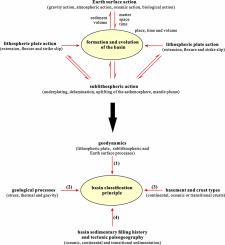当前位置:
X-MOL 学术
›
Gondwana Res.
›
论文详情
Our official English website, www.x-mol.net, welcomes your
feedback! (Note: you will need to create a separate account there.)
Geodynamic mechanism and classification of basins in the Earth system
Gondwana Research ( IF 7.2 ) Pub Date : 2020-10-01 , DOI: 10.1016/j.gr.2020.08.017 Yiwen Ju , Guangzeng Wang , Sanzhong Li , Ying Sun , Yanhui Suo , Ian Somerville , Wuyang Li , Bizhu He , Menglin Zheng , Kun Yu
Gondwana Research ( IF 7.2 ) Pub Date : 2020-10-01 , DOI: 10.1016/j.gr.2020.08.017 Yiwen Ju , Guangzeng Wang , Sanzhong Li , Ying Sun , Yanhui Suo , Ian Somerville , Wuyang Li , Bizhu He , Menglin Zheng , Kun Yu

|
Abstract The sedimentary basin is a basic geological unit in the Earth system: its formation and evolution are controlled mainly by plate tectonics and geodynamics, which have produced a variety of basin types. The development and evolution of various basins depend not only on the tectonic effect of lithospheric plate but also on sublithospheric, and Earth surface actions. Basin classification schemes based on the theories of platform–geosyncline or plate tectonics could neither include all basin types nor reflect the complex processes of basin formation and evolution. From the viewpoint of Earth system, we proposed a new basin classification scheme based on geodynamic mechanism—that is, lithospheric plate, sublithospheric, and Earth surface actions. In our geodynamic classification, we employed a series of geodynamic settings of basin formation and evolution, including the lithospheric plate, sublithospheric, and Earth surface environments, the dynamic regimes of basin formation and evolution, such as tectonic setting (extension, compression and shearing), the thermal processes and gravity effects, the various natures of basin basement and crustal types (continental, oceanic, or transitional crust), and the history of basin sedimentary filling and tectonic paleogeography successively, as the controlling factors for basin classification. This new geodynamic classification scheme highlights both the role of the lithosphere and the effects of the sublithospheric and the Earth surface actions on controlling the basin formation and evolution. The basic dynamic types of basin classification include the prototype basin forming under a single tectonic, thermal, or gravity regime and the superimposed basin as well as residual basin forming under multistage thermal and/or tectonic regimes. Thus, this classification scheme could provide an evolving understanding of lithosphere, crust–mantle interaction, and geodynamic processes as well as of hydrocarbon accumulation and metallogenic mechanisms in sedimentary basins and would help in the synthetic exploration of various resources.
中文翻译:

地球系统盆地的地球动力学机制与分类
摘要 沉积盆地是地球系统的一个基本地质单元,其形成和演化主要受板块构造和地球动力学控制,产生了多种盆地类型。各种盆地的发育演化不仅取决于岩石圈板块的构造作用,还取决于亚岩石圈和地表作用。基于台地地槽或板块构造理论的盆地分类方案既不能涵盖所有盆地类型,也不能反映盆地形成演化的复杂过程。从地球系统的角度,我们提出了一种基于地球动力学机制——岩石圈板块、亚岩石圈和地表作用的盆地分类新方案。在我们的地球动力学分类中,我们采用了一系列盆地形成和演化的地球动力学背景,包括岩石圈板块、亚岩石圈和地表环境,盆地形成和演化的动力机制,如构造背景(伸展、压缩和剪切)、热过程和重力效应、盆地基底和地壳类型(大陆地壳、大洋地壳或过渡地壳)的各种性质,以及盆地沉积充填的历史和构造古地理先后成为盆地分类的控制因素。这种新的地球动力学分类方案既突出了岩石圈的作用,也突出了次岩石圈和地表作用对控制盆地形成和演化的影响。盆地分类的基本动力类型包括在单一构造、热力或重力制度下形成的原型盆地和叠加盆地,以及在多级热力和/或构造制度下形成的残余盆地。因此,该分类方案可以提供对岩石圈、壳幔相互作用和地球动力学过程以及沉积盆地油气成藏和成矿机制的不断发展的理解,并将有助于各种资源的综合勘探。
更新日期:2020-10-01
中文翻译:

地球系统盆地的地球动力学机制与分类
摘要 沉积盆地是地球系统的一个基本地质单元,其形成和演化主要受板块构造和地球动力学控制,产生了多种盆地类型。各种盆地的发育演化不仅取决于岩石圈板块的构造作用,还取决于亚岩石圈和地表作用。基于台地地槽或板块构造理论的盆地分类方案既不能涵盖所有盆地类型,也不能反映盆地形成演化的复杂过程。从地球系统的角度,我们提出了一种基于地球动力学机制——岩石圈板块、亚岩石圈和地表作用的盆地分类新方案。在我们的地球动力学分类中,我们采用了一系列盆地形成和演化的地球动力学背景,包括岩石圈板块、亚岩石圈和地表环境,盆地形成和演化的动力机制,如构造背景(伸展、压缩和剪切)、热过程和重力效应、盆地基底和地壳类型(大陆地壳、大洋地壳或过渡地壳)的各种性质,以及盆地沉积充填的历史和构造古地理先后成为盆地分类的控制因素。这种新的地球动力学分类方案既突出了岩石圈的作用,也突出了次岩石圈和地表作用对控制盆地形成和演化的影响。盆地分类的基本动力类型包括在单一构造、热力或重力制度下形成的原型盆地和叠加盆地,以及在多级热力和/或构造制度下形成的残余盆地。因此,该分类方案可以提供对岩石圈、壳幔相互作用和地球动力学过程以及沉积盆地油气成藏和成矿机制的不断发展的理解,并将有助于各种资源的综合勘探。









































 京公网安备 11010802027423号
京公网安备 11010802027423号